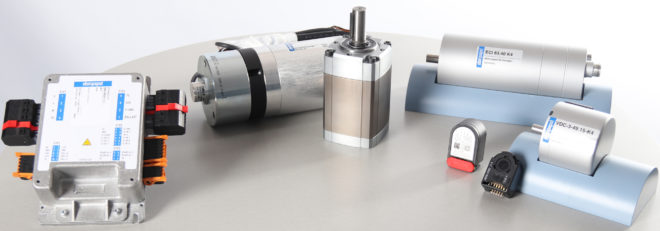Mr. Schumacher, why was the modular system developed?
In the past, the Industrial Drive Engineering business unit at ebm-papst focused on OEM projects. Our customers described exactly what kind of drive they wanted to purchase from us. Based on specific customer requirements, we developed special products for them. We still develop customer-specific OEM products, but at the same time we are ramping up our volume business. In other words: Customers tell us what they want. We look at our modular system and recommend a drive that best satisfies their requirements. In this case, we do not develop new products. Instead, we pick from a fixed modular system and combine individual modules to create a drive solution.
Does this mean the modular system is particularly suitable for small companies?
Exactly. And those are the customers we want to serve too. It used to be too expensive to initiate a development project for small special needs, but today that is a real option.
How is the modular system structured?
It basically contains five elements: motors, drives, electronics, brakes and sensors. A product always has to at least have a motor. There are three sizes available in the modular system: 42, 63 and 80 mm in an output range from 10 to 750 W. Since the motors typically have speeds of around 4,000 rpm, customers usually require a suitable drive. In this range, the requirements can vary greatly. One customer wants to have the drive inline, in front of the motor, and the next wants it at right angles and requires an angular gear. Other customers may have little installation space and require drives that are very flat. In this case, a spur gear is the solution. Our modular system contains a range of variants to meet customer requirements.

The modular system contains five elements: motors, drives, electronics, brakes and sensors.
What do you have to take into consideration in the case of electronics?
When it comes to electronics, we have to have drive regulators, which integrate the logic and power electronics into the motor, in a range of variants to match different requirements. To do this, we have electronics ranging from simple speed controllers to complex positioning control units, and of course bus systems that can actuate the drive. And then we need brakes to reliably keep the motor in position. They must be pre-designed for the modular system to ensure that they fit into our motors later. The next element is the rotor position sensors. After all, in order to offer high positioning accuracy, I always need a high-resolution sensor system.
On the one hand, the individual elements of the modular system are standardized and on the other, highly differentiated. How do you manage that?
We differentiate between preferred and standard types in the modular system. Preferred types are ready to ship within 48 hours. Availability is a key customer requirement when it comes to development. The faster the developer has something to work with, the more likely he is to identify with the task and continue working with what he has on the workbench.
How many drive solutions can be created using the modular system?
Currently, over 4,000 drive variants are in the system. We could theoretically create many more. The modular system is constantly growing and changing.
Is there a size limit for parts from the modular system?
Not really; the basic issue is availability. Therefore, end customers can order a maximum of 20 pieces per order. Of course we define a framework within which repeat customers can order – regardless of whether they require 5,000 or 50,000 pieces.
What challenges were involved in creating the modular system?
The solutions from the modular system had to be suitable for a wide variety of purposes in the equipment technology and industrial automation sectors. There are numerous applications. We had to give up the idea that everything always has to be cost-optimized to the maximum extent. In some cases, we achieve variance and repeat use by offering a little more.

Leave a comment